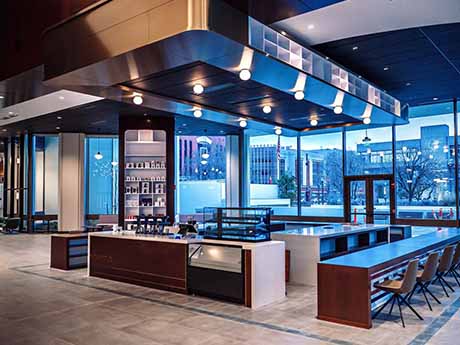Like many regional peer cities, there is a clear bifurcation between office leasing activity in Louisville’s downtown and suburban office markets.
Downtown Louisville has been slower to recover from the double gut-punch of the COVID-19 pandemic and local social unrest that kept workers away from the office in 2020, with overall vacancy stubbornly exceeding 20 percent for most of this year. Much of the vacancy has been driven by health insurer Humana, by far the largest office occupier in downtown Louisville, which has let several large Class B office leases expire as it continues to consolidate its workforce into properties the company owns.

Year-to-date, downtown leasing activity totals 115,000 square feet, which is up 58 percent compared to this time last year, while overall absorption has swung sharply lower at negative 237,000 square feet.
The relative oversupply of available office space has created a very “tenant-friendly” dynamic downtown, with landlords becoming increasingly aggressive to court leasing activity. More so than their suburban counterparts, downtown landlords are offering outsized incentive packages to tenants, including rental concessions, turnkey construction delivery of new tenant space, termination options and rental abatement periods that in some cases extend beyond one year.
In exchange, downtown tenants are agreeing to longer overall term lengths, often in excess of 10 years, to allow landlords a longer window to amortize incentives.
Downtown leasing activity is being driven largely by in-market renewals as existing downtown tenants downsize into higher-quality Class A spaces. For tenants today, offices need to offer more than what an employee can get at home.
Case in point: New York- and Nashville-based owners SomeraRoad recently completed a $20 million project to renovate its building lobby, street-level façade and elevator systems, as well as create a tenant-only amenity floor with an outdoor terrace and entertainment space. The improvements have been extraordinarily well-received, with 65,000 square feet of new lease commitments and 50,000 square feet of tenant renewals signed at the tower since the completion of the project earlier this year.
Following on those successes, Indianapolis-based KennMar Group recently acquired the nearby Fifth Third Tower and has announced a $10 million renovation plan for that building as well. The improvements at that building similarly will include upgrades to the building lobby, elevator systems, fitness center and tenant lounge — amenities that have become crucial, if not required, to retain and attract new tenants.
By comparison, the suburban Louisville office market is generally steady, buoyed by exceptional performance within the suburban Class A inventory. Total square footage of suburban leasing activity has outpaced downtown by an approximate 3-to-1 margin to this point in 2023. Although total absorption for the suburbs is slightly negative for the year at negative 69,300 square feet, total suburban vacancy currently registers a historically healthy mark of 14 percent.
With little new office construction in the pipeline, suburban office inventory appears balanced with total market demand resulting in suburban tenants not finding such heavily incentivized offers from landlords as compared to downtown.
Through this point in the year, suburban leasing activity can best be characterized as a “flight to quality” as tenants relocate from older, Class B properties into newly constructed Class A spaces. For instance, the six-building Shelbyhurst Office Complex, which is home to key local employers Churchill Downs, Brightspring Health and Steel Technologies, is effectively full. The newest building at the campus was completed during the pandemic yet leased up quickly, commanding top-of-market rents in the high $20 per square foot range.
Similar to Shelbyhurst, the Olympia Office Park on the north side of the suburbs and Old Henry Crossings in the far eastern suburbs are all full and performing well. These Class A buildings all feature modern architectural design with exceptionally efficient floorplates, allowing tenants to get a bigger bang for their buck. Add in the fact that these properties are all located close to suburban retail amenities and where employees live, it only broadens their appeal for employees as great places to work.
In the broader picture, both for downtown Louisville and the suburbs, the coming wave of debt maturities will have a significant effect on underperforming office assets. Particularly in older Class B properties with high vacancies, rent growth has remained stagnant while tenant fit-out construction costs have continued to escalate. That unfortunate combination of economic factors is conspiring to hinder occupancy and ultimately could imperil some property owners when notes come due.
— By Brent Dolen, CCIM, Senior Director, Cushman & Wakefield| Commercial Kentucky. This article was originally published in the September 2023 issue of Southeast Real Estate Business.


